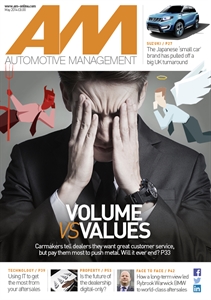The tensions between manufacturing and marketing are never more clear in the franchised sector than in the combination of pressures on dealers to sell agreed volumes of vehicles and to meet the standards set in sales and marketing strategies.
The pressure on dealers to ensure customers complete surveys based on their buying experience – and the reward for high scores – is small compared with the influence of the massive machinery of global vehicle production, with factories setting output far in advance of a car being marketed.
Sales targets are accompanied by customer satisfaction demands, but the rewards for achieving the former – fulfilling the end goal of the manufacturing plan – outweigh the latter and this influences behaviour in the showroom.
NEED TO KNOW |
|
|
♦ Most manufacturers incentivise sales over service ♦ Volume pressure ‘can benefit the customer’ ♦ CSI processes say little about real customer service |
|
 |
|
| 'Volume VS Values is the cover story in the May print edition of AM. Click on the cover above to subscribe or read a preview sample of the May issue here. |
A dealer may have a worse CSI score because it seems tougher on customers, such as ‘driving a deal’ (“I’ll skip introducing you to the service adviser”) to win business. Yet this relatively negative experience for the customer – and compared with the national sales companies’ (NSCs) sales and marketing strategies – achieves the goal of shifting stock.
This contradiction is ingrained in motor retailing, but what is its impact for dealers and can it be resolved?
Paul Burrows, automotive mergers and acquisitions adviser at Grant Thornton, said: “Moving metal is fundamental to the automotive industry and volume incentives remain a primary driver to that concept. The system works well when the market is positive and retail remains as strong as it has been for the last year or so.
“The problem arises when demand flattens or tails off, but production ordered for the UK remains high. This leads to pre-registration activity, which starts to create severe retailer problems.” Burrows doubts there is a solution to this in the short term. “But at least the volume targets and/or rewards can be flexed so there is a modicum of safety built into the system,” he said.
In the medium to long term, there may be an option to change to a fixed reward arrangement, much as some fleet business is transacted, but not specifically volume-related. This would be a massive change requiring much debate.
“It could be extremely destabilising and potentially ruinous, but might have a chance to succeed if PCPs and consumers’ desire to have a monthly outgoing rather than a one-off capital spend become the norm,” Burrows said.
“This will need to cover a part of the used car market as well as new because otherwise indigestion in the system will create problems.”
If the change does happen, then volume and interest rate management become intertwined and volume is theoretically more in the realm of the manufacturer to influence and thus less of a threat.
The industry may eventually go this way and rewarding retailers in a different manner could follow. But any new system must provide for profitable, stable, customer-facing operations to offset the cost of facilities and brand standards.
What are the elements of great customer service?
Guy Ainsley, a former director of dealer groups Caffyns and Inchcape Retail UK and founder of consultancy FFDL, said consumers experience great customer service through a combination of product quality, the buying experience (process and outcome) and aftercare.

















Old Codger - 09/05/2014 17:54
Have battled over the year with many manufacturers whose CSI systems all seem to have been provided by the same consultants. Take the inevitable question "Are you satisfied or completely satisfied " ? I have tried convincing manufacturers that the question is tautological by saying "My old grandfather Fred is dead but he would be no more so if he were completely dead" However I have never managed to get a manufacturer to change the question which seems calculated to achieve for the dealer a less than 100% score